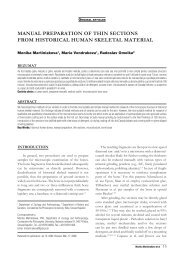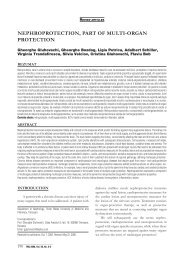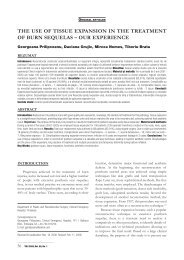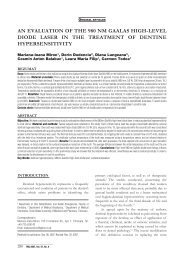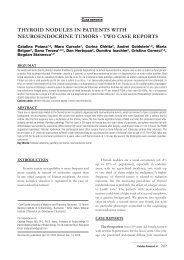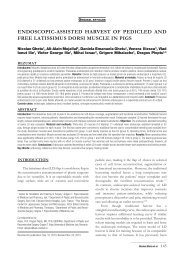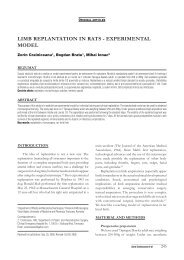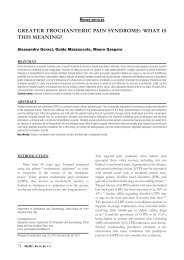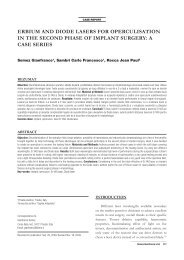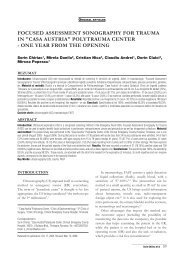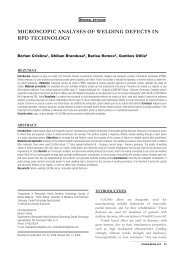MEtallographic aspEcts of wEldings bEtwEEn orthodontic rings and ...
MEtallographic aspEcts of wEldings bEtwEEn orthodontic rings and ...
MEtallographic aspEcts of wEldings bEtwEEn orthodontic rings and ...
You also want an ePaper? Increase the reach of your titles
YUMPU automatically turns print PDFs into web optimized ePapers that Google loves.
ORIGINAL ARTICLES<br />
<strong>MEtallographic</strong> <strong>aspEcts</strong> <strong>of</strong> <strong>wEldings</strong> <strong>bEtwEEn</strong><br />
<strong>orthodontic</strong> <strong>rings</strong> <strong>and</strong> wirEs<br />
Cristina Bortun, Florica Glavan, Sorin Porojan, Liliana S<strong>and</strong>u, Otilia Gombos<br />
rEZUMat<br />
Introducere: Aparatele ortodontice fixe sunt frecvent utilizate n practica medicinei dentare. Quad Helix/Crib Therapy este unul din aparatele tip MIA (Mobile<br />
Intraoral Arch) cu arcuri aplicabile palatinal sau lingual, sudate de inele ortodontice aplicabile pe molari, ce este utilizat n anomalii dentomaxilare, cum<br />
ar fi: endogna]ia maxilar\, ocluzia deschis\. Obiective: Obiectivul principal al studiului este cel de a determina parametrii optimi de imbinare sudat\ cu<br />
microimpulsuri a componentelor aparatului ortodontic. Material [i metode: S-au utilizat inele ortodontice (Ormco, Ormco Corporation, West Collins USA)<br />
uzate, srma de CoCr Finolloy (Fino, Bad Bocklet, Germany) sau de Wipla Oste<strong>of</strong>ix (Zelezarny, Chomutov, Cehia) pentru sudarea arcurilor la inele. A fost folosit<br />
aparatul de sudur\ cu microimpulsuri Welder (Schutz Dental). Sudurile au fost analizate metalografic [i li s-au evaluat microdurit\]ile, pentru a defini parametrii<br />
optimi de sudur\ (putere 3; timp /punct sudur\ 40msec.; interval de timp ntre impulsuri 1 sec.; timp de curgere a argonului nainte de sudare 1 sec.). Rezultate<br />
[i discu]ii: Analizele microscopice ale sudurilor arcurilor linguale la inele ortodontice au relevat structurile caracteristice ale aliajelor metalice din zona de baz\,<br />
zona sudat\ [i zona de influen]\ termic\. S-a constatat c\ duritatea srmei de wipla este dubl\ fa]\ de cea a inelului ortodontic, ceea ce impune anumite condi]ii<br />
de sudur\. Dac\ nu este luat n calcul acest fapt [i experien]a pr<strong>of</strong>esional\, la mbin\rile sudate se deterioreaz\ inelul ortodontic. Concluzii: 1. Se indic\ s\ se<br />
sudeze inelele ortodontice cu srm\ de wipla. 2. Sudura tangen]ial\ este mult mai confortabil\ dect cea punctiform\ [i d\ rezultate mai bune.<br />
Cuvinte cheie: inele ortodontice, sudura cu microimpulsuri, srm\ de CoCr, srm\ de wipla<br />
abstract<br />
Introduction: Fixed <strong>orthodontic</strong> devices are frequently used in Dental Medicine. Quad Helix/Crib Therapy is an MIA (Mobile Intraoral Arch) with palatal or<br />
lingual appliance, used for Dento-skeletal anomalies like: constricted maxillary, open bite. It uses <strong>orthodontic</strong>s <strong>rings</strong> that can be fixed on molars. Objectives:<br />
The main objective <strong>of</strong> the study is to determine the optimal parameters <strong>of</strong> microplasma-welded joints, for the compounds <strong>of</strong> the <strong>orthodontic</strong> devices. Material<br />
<strong>and</strong> methods: We used worn-out <strong>orthodontic</strong> <strong>rings</strong> <strong>and</strong> Wipla <strong>and</strong> CoCr wires, in order to weld the arches to the <strong>rings</strong>. Microplasma Welding Device (Schutz<br />
Dental- Rosbach, Germany) was used for welding. In order to define the optimal welding parameters (Power 3; time/ welding point 40msec.; time between<br />
impulses 1 sec.; time for Argon running before pointing 1 sec.), the weldings underwent a metallographic analysis <strong>and</strong> a microhardness evaluation. Results:<br />
The structural analyses <strong>of</strong> welding zone between lingual arches <strong>and</strong> <strong>orthodontic</strong> <strong>rings</strong> revealed typical alloys structure from the base material, welding material<br />
<strong>and</strong> heat affected zone. The microhardness <strong>of</strong> Wipla wire is twice as that <strong>of</strong> the <strong>orthodontic</strong> ring, which imposes some special welding conditions. If this fact is<br />
not considered, the <strong>orthodontic</strong> <strong>rings</strong> can be destroyed. Conclusions: 1. It is recommended to weld the <strong>orthodontic</strong> <strong>rings</strong> using Wipla wire. 2. The tangential<br />
welding is much more comfortable compared with the point-like one <strong>and</strong> has better results.<br />
Key Words: <strong>orthodontic</strong> <strong>rings</strong>, microplasma welding, CoCr wire, wipla wire, metallographic analysis, hardness<br />
introdUction<br />
The alloys used in Orthodontics <strong>and</strong> in the Denture<br />
Technology are metallic structures, obtained through<br />
the melting <strong>of</strong> many chemical metallic compounds<br />
(Co, Cr, Mo, Ni, Ti, etc). 1-8 Generally, the alloys used in<br />
dentistry have to fulfill specific conditions, in order to<br />
be used in the oral cavity:<br />
Department <strong>of</strong> Removable Partial Dentures Technology, Faculty <strong>of</strong> Dentistry,<br />
Dental Technology Specialization, Victor Babes University <strong>of</strong> Medicine <strong>and</strong><br />
Pharmacy Timisoara<br />
Correspondence to:<br />
Pr<strong>of</strong>. Cristina Bortun, 9 Revolutiei din 1989 Blvd., Timisoara, Romania<br />
Email: cristinabortun@yahoo.com<br />
Received for publication: Jul. 10, 2007. Revised: Dec. 12., 2007.<br />
a. To have corrosion strength, no matter the<br />
processing types; the alloy compounds to be chemically<br />
stable, without any influence <strong>of</strong> various factors or the<br />
pH-alteration in the mouth.<br />
b. The mechanical characteristics <strong>of</strong> the devices or<br />
dentures to be optimal for the stress developed during<br />
the functions <strong>of</strong> dento-maxillar apparatus (elasticity,<br />
tearing strength, wear, etc)<br />
The fixed <strong>orthodontic</strong> devices appeared due to<br />
the necessity <strong>of</strong> solving complicated cases <strong>of</strong> dentalmaxillary<br />
anomalies, as fast as possible <strong>and</strong> with a<br />
permanent control <strong>of</strong> dental movements. These devices<br />
are helpful both for the coronal or radicular movement<br />
<strong>and</strong> the entire dento-parodontal units movement.<br />
Lately, a new era was opened in the Orthodontic<br />
appliance, which is in connection with the placement<br />
<strong>of</strong> the <strong>orthodontic</strong> device depending on the minimum<br />
visibility.<br />
_____________________________<br />
Cristina Bortun et al 199
a<br />
b<br />
c<br />
Figure 1. Orthodontic device <strong>of</strong> type Quad Helix: a. situated on the cast;<br />
b. detached from the cast; c. ring-arch welding detail<br />
The coming out <strong>of</strong> a new series <strong>of</strong> devices like<br />
MIA (Mobile Intraoral Arch) satisfies the patients<br />
not only <strong>orthodontic</strong> but also esthetically. We<br />
insisted on the Quad Helix, an <strong>orthodontic</strong> device<br />
with <strong>orthodontic</strong> <strong>rings</strong>, on which an oral arch is<br />
attached. 5,9 The <strong>orthodontic</strong> <strong>rings</strong> are placed on the<br />
molars <strong>and</strong> the palatal or lingual arch is welded on<br />
these <strong>rings</strong>.<br />
The arch, which is orally placed, moves<br />
symmetrically or asymmetrically various groups <strong>of</strong><br />
teeth <strong>and</strong> can solve complicated anomalies (maxillary<br />
disjunction, open bite, posterior cross bite), without<br />
being noticed by the entourage. From this group <strong>of</strong><br />
devices, we present a QUAD HELIX/CRIB variant,<br />
created at the Orthodontic Department in Timisoara<br />
<strong>and</strong> which was tested. (Fig. 1)<br />
_____________________________<br />
200 TMJ 2008, Vol. 58, No. 3 - 4<br />
Generally, Orthodontics uses voltaic arch point<br />
soldering which <strong>of</strong>ten is followed by failures <strong>and</strong>/or<br />
the deterioration <strong>of</strong> the <strong>orthodontic</strong> ring. The concept<br />
<strong>of</strong> joints welded using microimpulses or laser welding<br />
was tested in Prosthodontics, (but not frequently) <strong>and</strong><br />
only rarely for the <strong>orthodontic</strong> devices. 3,4,10-17 For this<br />
reason, we tested the system in order to indicate the<br />
right solution: no matter the welding procedures or<br />
the material precipitate, always structures (<strong>rings</strong> <strong>and</strong><br />
arches) modification takes place, especially in the<br />
heat-affected zone (HAZ), namely near the welded<br />
zone. Here, due to the overheating, precipitates <strong>of</strong><br />
some compounds can appear <strong>and</strong> hardens the zone.<br />
MatErial <strong>and</strong> MEthods:<br />
We studied 15 joint samples, welded with material<br />
addition, on worn out <strong>orthodontic</strong> <strong>rings</strong> (Ormco,<br />
Ormco Corporation, West Collins USA). For these<br />
joints, two types <strong>of</strong> wire were used, Wipla Oste<strong>of</strong>ix<br />
(FeCrNi) (Zelezarny Chomutov, Chomutov, Cehia)<br />
wire <strong>and</strong> CoCr Finoloy (Fino, Bad Bocklet, Germany)<br />
wire. The welding was performed with a microimpulse<br />
device (Schütz Dental, Rosbach, Germany). (Fig. 2)<br />
The welding were point-like when the wire position<br />
was vertically (perpendicular on the ring) <strong>and</strong> linear, in<br />
case <strong>of</strong> an oblique position <strong>of</strong> the welded joints.<br />
The welding parameters were those indicated (for<br />
these types <strong>of</strong> stainless steels) by the company that<br />
produces microplasma welder (Schütz Dental): Power<br />
3; time/ welding point 40msec.; time between impulses<br />
1 sec.; time for Argon running before pointing 1 sec.<br />
We used the following sequence <strong>of</strong> the experimental<br />
program, in order to evaluate the welded joint:<br />
- Evaluation <strong>of</strong> the chemical composition <strong>of</strong> the<br />
alloys, through metallographic analysis (structure,<br />
defects) <strong>and</strong> hardness tests.<br />
- Evaluation <strong>of</strong> the welded joints, probes loading,<br />
metallographic analysis (structure, defects), <strong>and</strong><br />
hardness attempts on specific zones: base material,<br />
heat affected zone, welding zone.<br />
- Establishment <strong>of</strong> optimal possibilities for<br />
welding <strong>and</strong> loading, followed by analysis <strong>and</strong> tests.<br />
Microscopic observations were made using an inverted<br />
metallographic microscope Reichert MeF 2 (Reichert, NY,<br />
USA). Therefore the samples were incorporated into an<br />
acrylic resin, cut perpendicularly to the weld axis, grinded<br />
using silicon carbide abrasive paper <strong>and</strong> polished with a<br />
series <strong>of</strong> abrasives rubbers. The surfaces to be analyzed<br />
were chemically attacked using acid solution <strong>of</strong> ferric<br />
chloride for 2-3 seconds at room temperature. The images<br />
magnification was 100x on polarized light.
a<br />
b<br />
c<br />
Figure 2. Welder Schűtz Dental - a. welding equipment; b. Ormco<br />
<strong>orthodontic</strong> ring (Ormco Corporation, West Collins USA); c. Welded joining<br />
on an <strong>orthodontic</strong> ring with two types <strong>of</strong> wire (wipla- thick wire <strong>and</strong> CoCr-<br />
thin wire)<br />
a<br />
b<br />
c<br />
d<br />
e<br />
f<br />
_____________________________<br />
Cristina Bortun et al 201
a<br />
g<br />
h<br />
i<br />
Figure 3. Metallographic structures <strong>of</strong> ring, welding area <strong>and</strong> wire: a.<br />
Martensite <strong>and</strong> fine carbids - Oste<strong>of</strong>ix Wipla; b. Solid solution <strong>of</strong> CoCr; c.<br />
Orthodontic ring; d,e. Details - welded joint zones: BM,HAZ,WM; f. Ring<br />
with Wipla wire welded zone; g. Ring with Finolloy CoCr wire (Fino, Bad<br />
Bocklet, Germany) welded zone; h. Mixed zone <strong>of</strong> ring-wipla alloys; i.<br />
Mixed zone <strong>of</strong> ring-CoCr alloys.<br />
Microhardness (HV) was measured on the polished<br />
surface <strong>of</strong> the samples at room temperature using a<br />
Zwick 3212 (Zwick, Ulm, Germany) microhardness<br />
unit.<br />
Individual tests with a peak load <strong>of</strong> 9.8 N (HV1)<br />
or 49 N (HV5), depending on probe thickness, <strong>and</strong> a<br />
loading time <strong>of</strong> 20 seconds were performed for each<br />
determination.<br />
_____________________________<br />
202 TMJ 2008, Vol. 58, No. 3 - 4<br />
rEsUlts<br />
Accomplishment <strong>of</strong> welded joints <strong>and</strong> analysis <strong>of</strong><br />
the results prove that the great majority <strong>of</strong> the samples<br />
point out the existence <strong>of</strong> a joint with austenitic <strong>and</strong>/<br />
or martensitic structure, with ferrite <strong>and</strong> carbides<br />
complex. This is the way the characteristic structures<br />
<strong>of</strong> the melted alloys are noted. 18<br />
Some metallographic aspects <strong>of</strong> alloys structures<br />
resulted after analysis are shown in Figure 3 (those <strong>of</strong><br />
wipla wire, CoCr wire <strong>and</strong> <strong>orthodontic</strong> ring, those <strong>of</strong><br />
welded joints <strong>and</strong> those where the alloys miscibility<br />
can be observed).<br />
The VICKERS hardness tests were realized with<br />
1kg load [HV1] (CoCr wire <strong>and</strong> <strong>rings</strong>) <strong>and</strong> 5kg [HV5]<br />
(wipla wire). Table 1 presents the results <strong>of</strong> the<br />
hardness tests performed on the samples.<br />
It has been noted that the hardness <strong>of</strong> wipla wire<br />
(with approximately 100 HV units) is twice as that <strong>of</strong><br />
the <strong>orthodontic</strong> ring, which imposes some welding<br />
precaution.<br />
Certainly, there were also joining failures, which<br />
resulted especially from the lack <strong>of</strong> experience in<br />
welding <strong>and</strong> from the inadequate welding parameters,<br />
like those presented in Figure 4. These failures can<br />
be visible: deterioration/melting <strong>of</strong> the <strong>orthodontic</strong><br />
ring, the welding itself being resistant at tearing.<br />
More failures can be noticed in case <strong>of</strong> wipla wire<br />
welding, which has a bigger microhardness.<br />
Figure 4. Failures in the welding <strong>of</strong> <strong>orthodontic</strong> <strong>rings</strong> arches<br />
discUssion<br />
The laser <strong>and</strong> microplasma welding are performed<br />
using through rapid, economic <strong>and</strong> highly accurate<br />
techniques. 12,13 Time is saved, because the frameworks<br />
are welded directly on the working cast. Distortions,<br />
which are caused by the transfer from the working cast,<br />
disappear; the welding can be done very close to the acrylic<br />
resins or the ceramics, without any damage or chromatic<br />
modification. Theoretically, all metals can suffer joining<br />
processes. 16,17,19,20 Sometimes, when the cooling is to fast,<br />
we observe cracks in the base material. 14,15
Table 1. Microhardness <strong>of</strong> some welding areas<br />
Track no Material<br />
The modern lasers, like Girrbach Dental System<br />
(Neolaser L 126500), Vision Industry (LWI 4 th<br />
Generation), Interdent Laser System (Herculea),<br />
Manfredi, can be electronically programmed; they have<br />
a microscopic visualization system <strong>and</strong> the parameters<br />
can be set depending on the welded alloy. The welding<br />
has a maximum stability, gives a biocompatible zone,<br />
which is mechanically resistant <strong>and</strong> can be realized<br />
rapidly <strong>and</strong> with maximum precision, also at room<br />
temperature.<br />
Experimentally, some alloys used in Dental<br />
Technology have been welded using laser techniques.<br />
Their quality can be estimated through destructive <strong>and</strong><br />
nondestructive methods. 5,14,21-23 The metallographic<br />
analysis <strong>and</strong> microhardness evaluation belong to<br />
the destructive methods, while Spectrographic <strong>and</strong><br />
Radiologic analyses are nondestructive. Our studies<br />
regarding laser Nd:Yag welding were made with help<br />
<strong>of</strong> Welding Department from Politehnica University<br />
Timisoara <strong>and</strong> researchers from ISIM/ WMTI<br />
Timisoara (Welding <strong>and</strong> Materials Testing Institute);<br />
they demonstrated a good compactness <strong>of</strong> the<br />
studied samples <strong>and</strong> the lack <strong>of</strong> defects in the joining<br />
area. 14<br />
Orthodontic ring CoCr wire Wipla wire<br />
Vickers HV1 HV5<br />
BM HAZ WM BM HAZ WM BM HAZ WM<br />
0 1 2 3 4 5 6 7 8 9 10<br />
1<br />
193 229 210 368 - - 454 - -<br />
2 RING 1<br />
210 228 210 378 - - 466 - -<br />
3 214 229 210 389 - - 480 - -<br />
1<br />
239 - 224 368 - - 460 - -<br />
2 RING 2<br />
219 - 229 378 - - 460 - -<br />
3 214 - 234 358 - - 454 - -<br />
1<br />
205 219 197 358 - - 473 - -<br />
2 RING 3<br />
201 218 201 378 - - 488 - -<br />
3 202 210 224 348 - - 473 - -<br />
1<br />
201 215 225 360 476<br />
2 RING 4<br />
209 224 226 354 484<br />
3 198 213 236 367 463<br />
1<br />
204 220 235 358 459<br />
2 RING 5<br />
189 211 232 362 469<br />
3 207 210 227 369 456<br />
The microhardness evaluation was realized with<br />
loads <strong>of</strong> 100g; it pointed out a light increase <strong>of</strong> the<br />
hardness in HAZ (heated affected zone). The hardness<br />
values <strong>of</strong> the weld metal (WM) are situated between<br />
those in the base material (BM) <strong>and</strong> heat affected zone<br />
(HAZ). Regarding the chemical composition <strong>of</strong> the<br />
joint, a small diminution <strong>of</strong> the main reactive elements<br />
has been noticed. In the testing base material <strong>of</strong> over<br />
1 mm thickness cracks appear, which can be observed<br />
not only macroscopically but also by metallographic<br />
study That is why, at 1 mm thickness, we recommend<br />
welding without material addition, while, for the rest,<br />
material addition being necessary <strong>and</strong> m<strong>and</strong>atory.<br />
The microplasma welding <strong>of</strong>fers good quality<br />
at a reasonable price <strong>and</strong> rapidly. The (effective)<br />
welding takes place also under the microscope, in a<br />
way the spot overlapping should be optimal, namely<br />
more than ½. Different types <strong>of</strong> welding on dental<br />
alloys used in Removable Partial Denture Technology<br />
were experimented before; this is the reason why we<br />
considered interesting this experience in Orthodontics.<br />
On this type <strong>of</strong> welding, the alloy’s lowest thickness is<br />
0.4-0.5 mm, while in that <strong>of</strong> the <strong>orthodontic</strong> ring the<br />
ring thickness is 0.3 mm. Therefore, there were some<br />
_____________________________<br />
Cristina Bortun et al 203
welding difficulties when the power degree was too<br />
high, because the <strong>orthodontic</strong> ring effectively melted.<br />
conclUsions<br />
1. It is recommended to weld the <strong>orthodontic</strong><br />
<strong>rings</strong> using Wipla wire.<br />
2. The tangential welding is much more<br />
comfortable in comparison with the point-like one<br />
<strong>and</strong> has better results.<br />
acKnowlEdgEMEnt<br />
This study was supported by the CNCSIS Grant<br />
Type A, No. 744/2006<br />
rEfErEncEs<br />
1. Andreasen GF, Morrow RE. Laboratory <strong>and</strong> clinical analyses <strong>of</strong> nitinol<br />
wire. Am J Orthod 1978;73:142-51.<br />
2. Brantley WA, Eliades T. Orthodontic materials: Scientific <strong>and</strong> clinical<br />
aspects. Stuttgart: Thieme, 2001, p. 84-97.<br />
3. Dobberstein H, Orlick H, Fisher P, et al. Experimental studies <strong>of</strong> the<br />
laser welding <strong>of</strong> Cr-Co alloys using a pulse laser Nd-Yag. Zahn, Mund<br />
Kieferheilkunde Mit Zentralblatt 1989;77:578-9.<br />
4. Dobberstein H, Orlick H, Zuhrt R. The welding <strong>of</strong> cobalt-chromium,<br />
nickel-chromium <strong>and</strong> silver-palladium alloys using a solid state laser.<br />
Zahn Mund Kieferheilkunde Mit Zentralblatt 1990;78:259-61.<br />
5. Ghiban B, Bortun C, S<strong>and</strong>u L. Structural features in cobalt based alloys<br />
for dental applications. Bull. Transilvania Univ. Brasov 2007;II:80-6.<br />
6. Kusy RP. Orthodontic biomaterials: from the past to the present. The<br />
Angle Orthodontist 2002;72(6):501-2.<br />
7. Lyman T. (Ed). Metals H<strong>and</strong>book. Volume 1. Properties <strong>and</strong> Selection<br />
<strong>of</strong> Metals. 8 th Ed. Ohio: American Society for Metals, 1961, p.<br />
_____________________________<br />
204 TMJ 2008, Vol. 58, No. 3 - 4<br />
1016-21, 1030-1.<br />
8. Miura F, Mogi M, Ohura Y, et al. The super-elastic property <strong>of</strong> the<br />
Japanese NiTi alloy wire for use in <strong>orthodontic</strong>s. Am J Orthod<br />
Dent<strong>of</strong>acial Orthop 1986;90:1-10.<br />
9. Castañer-Peiro A. Interceptive <strong>orthodontic</strong>s: The need for early diagnosis<br />
<strong>and</strong> treatment <strong>of</strong> posterior crossbites. Med Oral Patol Oral Cir Bucal<br />
2006;11:E210-4.<br />
10. Cozza P., Mucedero M, Baccetti T., et al. Treatment <strong>and</strong> posttreatment<br />
effects <strong>of</strong> quad helix/crib therapy <strong>of</strong> dentoskeletal open bite. The<br />
Angle Orthodontist 2007;77(4):640-5<br />
11. Becker CM, Benthem H. Van Laseranwendung zur materialbearbeitung.<br />
Dtsch Zahnärztl Z 1994;49:119-23.<br />
12. Bertr<strong>and</strong> C, Le Petitcorps Y, Albingre L., et al. The laser welding<br />
technique applied to non precious dental alloys procedure <strong>and</strong> results.<br />
Br Dent J 2001;190(5):255-7.<br />
13. Bertr<strong>and</strong> C, Le Petitcorps Y, Albingre L., et al. Optimization <strong>of</strong> operator<br />
<strong>and</strong> physical parameters for laser welding <strong>of</strong> dental materials. Br Dent<br />
J 2004;196:413-8.<br />
14. Bortun C, Mitelea I, Milos L, et al. Analysis <strong>of</strong> laser welded joints on<br />
„C” alloy used in removable partial dentures technology. Eur Cell<br />
Mat 2005;10(Suppl. I):31.<br />
15. Brooks J. Effect <strong>of</strong> alloy modifications on HAZ Cracking <strong>of</strong> A286<br />
stainless Steel. Welding J 1974;517-23.<br />
16. H<strong>of</strong>fman J. Dental laser welding technique. Procedural report. 1.<br />
Quality, expense, <strong>and</strong> risks <strong>of</strong> innovative bonding technique. Dental<br />
Labor Munch 1992;40(7):1221-4.<br />
17. H<strong>of</strong>fmann J. Dental laser welding technique. Procedural report. 2.<br />
Indications for use <strong>of</strong> innovative technique. Dental Labor Munch<br />
1992;40(8):1321-8.<br />
18. Ghiban B, Cosmeleata G. Transformations, Structure <strong>and</strong> Properties <strong>of</strong><br />
Materials. Printech: Bucuresti, 2002.<br />
19. Brown DV. Metallurgy basics. New York: Van Nostr<strong>and</strong> Reinhold,<br />
1983, p. 4-5.<br />
20. Humphrey WR. The forum: chrome alloy in orthodontia. Is it here to<br />
stay? Int J Orthod Dent Children 1935;21:594-5.<br />
21. Cosmeleata G, Ghiban B. Fundamental principles <strong>of</strong> physical<br />
metallurgy, Printech: Bucuresti, 2000.<br />
22. Ghiban B. Corrosion <strong>and</strong> protection <strong>of</strong> metallic materials, Printech:<br />
Bucuresti, 2004.<br />
23. Ghiban B. Elements <strong>of</strong> physical metallurgy - Metallography practice for<br />
students, Printech: Bucuresti, 2000.



